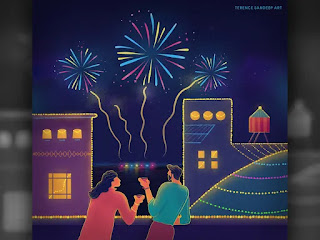Tihar
Tihar is considered as another great festival after Dashain. It is also called Diwali in the Terai region. The five days celebrated from the thirteenth day of Kartik Krishna Paksha to the second day of Kartik Shukla Paksha are also called Yamapanchak. Gai Tihar is also called Dipawali as it is celebrated in every house on these five days and especially on the evening of Aunsi or on the evening of Gai Tihar during the worship of Lakshmi. From the religious, cultural, and spiritual point of view, Tihar is considered as an excellent festival.
The first day is observed as Kag Tihar on which crow is worshipped and fed early in the morning. This bird is considered the messenger of both good and bad news. On the second day, Kukur Tihar, people worship the dog, a faithful friend and guard of man that is also considered the gatekeeper of Yama, God of death. People garland the dog and give it a variety of delicious food.
The cow is worshipped on the third day, Gai Tihar. The cow is revered by Hindus as the mother and goddess of wealth and prosperity. In the evening house is illuminated with multi-color lights as well as oil-lit clay lamps called palas. Firecrackers are exploded and the night view resembles a sparkling diamond. With a lot of devotion, people worship Laxmi, the Goddess of wealth, in the echoes of Deusi-bhailo. For this, they have made complete cleaning of their house and bought various items of worship. People heartily donate, rice grains, delicious food, and money to the performers of Deusibhailo who visit door to door singing Tihar songs and expressing blessings and best wishes.
The fourth day is Goru Tihar, the day of oxen that are used widely to plow the field in Nepal. People apply oil on its horns, worship it and give delicious food including selroti. It is also called Govardhan Puja day and the mountain of cow dung is worshipped.
The fifth day of the festival is called Bhai Pooja or Bhai Tika. This is the last day of the festival. On this day, the sisters worship the brothers and wish them good luck and longevity. Brothers and sisters also pay homage to their sisters. On this day, colorful tikas are putten on the forehead. In particular, there is a tradition of wearing a garland of green dubo and never-ending velvet flowers and wishing good health and longevity to the brothers.
In Nepali society, Tihar is considered a very important festival for children to eat, play, dance, and sing together by making home full of different kinds of lights. For the elderly around the house, on the one hand, this wealth is a sacred festival of worship and adoration of Goddess Lakshmi, and on the other hand, it is also an opportunity for a family reunion. For brothers and sisters, Tihar is a heartfelt celebration of each other's well-being and longing for each other's longevity.
Activities such as worshiping various animals during the festival, adding light to every household, having the opportunity to sing and dance like Deusi and Bhailo as a part of the festival, use of flower garlands and colored cysts, recurring cordial relationship between brothers and sisters, etc. It can be said to be an important feature of this festival.
Even though it is a festival celebrated with various entertainments, it has some good aspects and some bad aspects. In the name of Tihar, playing deusi and bhailo is to preserve our own culture. The ones that should be considered as the good side are the ones who enjoy drinking and drinking in the name of the same goddess indulging in gambling, engaging in activities that cause unrest in the family and society, inciting arrogance, etc. Therefore, the festival has a special significance as it is a sacred festival that deepens the relationship between brothers and sisters with various worships.





